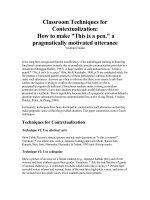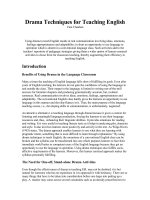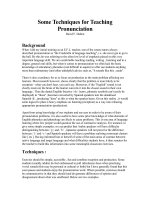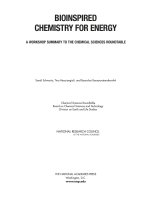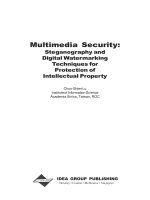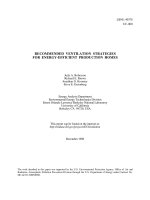Software techniques for energy efficient memories
Bạn đang xem bản rút gọn của tài liệu. Xem và tải ngay bản đầy đủ của tài liệu tại đây (3.62 MB, 173 trang )
Software Techniques for
Energy Efficient Memories
Pooja Roy
(M.S., University of Calcutta, 2010)
A THESIS SUBMITTED
FOR THE DEGREE OF DOCTOR OF PHILOSOPHY
DEPARTMENT OF COMPUTER SCIENCE
SCHOOL OF COMPUTING
NATIONAL UNIVERSITY OF SINGAPORE
December 2014
Declaration
I hereby declare that this thesis is my original work and it has been written by
me in its entirety. I have duly acknowledged all the sources of information
which have been used in the thesis. This thesis has also not been submitted for
any degree in any university previously.
(POOJA ROY)
i
Abstract
The recent times are known as the dark silicon era. Dark implies the percent-
age of the chip that cannot be switched-on at a given time to keep the power
consumption in budget. As a consequence, researchers are innovating energy
efficient systems. Memory subsystem consumes a major part of energy and so
it is imperative to evolve them into energy-efficient memories. In the past few
years, new memories such as resistive memories or non-volatile memories have
emerged. They are inherently energy efficient and are promising candidates for
the future memory devices. However, the application and program layer is not
aware of the new memory and new architectural designs. Thus, the application
layer is not specifically optimized for energy efficiency.
In this thesis, we propose compiler optimization and software testing methods
to optimize programs for energy efficiency. Our techniques provide cross-layer
support to fully utilize the advantages of the energy-efficient memories. In most
of our works, we assume a resistive technology based hybrid memories as L1 data
cache, L2, L3 and main memory level. In hybrid memory designs, data placement
is critical as the resistive memories are sensitive to write operations. Therefore,
it is common to place a smaller SRAM or DRAM alongside to filter the write
accesses. However, caches are transparent to the application layer and so it is
challenging to influence the data traffic to the caches at runtime. Our solution
is a new virtual memory design (EnVM) that is aware of resistive technology
based hybrid caches. EnVM is based on the memory access behaviour of a
iii
program and can control the data allocation to the caches. The merits of EnVM
diminish at the main memory level, as the size of basic data unit differs from
caches. Caches address cache line size data where as main memory addresses a
page which is much larger. We propose a new operating system assisted page
addressing mechanism that accounts for cache line size data even in the main
memory level. Thus, we can magnify the effects of hybrid memory at the main
memory level.
The next challenge is a characteristic of the energy-efficient memories that
makes them prone to errors (bit-flips). This is not only true for the resistive
memories, undervolted memories also exhibit such characteristics. Adapting
error detection and correction mechanisms often offsets the gain in power con-
sumption. We propose a framework that exploits the inherent error resiliency of
some application to solve this issue. Instead of mitigating, it allows errors if the
final output is within a given Quality of Service (QoS) range. Thus, it is pos-
sible to run such applications on the energy-efficient memories without having
to provide error-correction support. In addition, the gain in energy efficiency
is magnified. The above framework, based on a dynamic program testing ac-
crues a large search space to find an optimal approximation configuration for a
given program. The running time of the analysis and book-keeping overheads of
such techniques scales linearly with increase in program size (lines of code). In
out next work, we propose a static code analysis which deduces accuracy mea-
sures for program variables to achieve a given QoS. This compile-time framework
complements the dynamic testing schemes and can improve their efficiency by
reducing the search space.
In this thesis, we show that with proper support from the software stack,
it is possible deploy energy efficient memories in the current memory hierarchy
and achieve remarkable reduction in power consumption without compromising
performance.
iv
Acknowledgments
“You need the willingness to fail all the time. You have to generate many
ideas and then you have to work very hard only to discover that they don’t
work. And you keep doing that over and over until you find one that does
work.” – John Backus
I thank my advisor Professor Weng Fai Wong, who placed his trust in me, and
without whom this thesis would not be real. Prof. Wong has taught me all I know
about research and the art of solving problems. I learnt from him the kind of
rigor, focus and precision that is imperative in research. Not only he encouraged
me to generate new ideas, to work hard on them till it comes to fruition, he is also
the person I have always turned to regarding basics of compiler optimizations.
I am especially thankful for his patience and his faith in me during the most
difficult times of my research. I am always inspired by his integrity and sincerity.
I hope to be a researcher and a professor of brilliance as his.
I thank Professor Tulika Mitra, for her constant support, valuable guidance
and feedback. She has always been my inspiration since I joined the School of
Computing. I thank Professors Siau Cheng Khoo and Wei Ngan Chin for their
precious time and guidance. I thank Professors Debabrata Ghosh Dastidar and
Nabendu Chaki, for their support throughout my undergraduate and graduate
studies in India. I thank Dr. Rajarshi Ray and Dr. Chundong Wang for their
support as seniors, Manmohan and Jianxing for being amazing colleagues.
v
I thank my friends in Singapore for making this city a home away from home.
I am deeply thankful my wonderful roommates Damteii, Sreetama, Sreeja and
Priti for taking care of me everyday. I thank my friends in Kolkata, especially
Debajyoti, for their assurance and love in the times I needed the most. I thank
all my seniors and friends of Soka Gakkai, especially Dr. M. Sudarshan, for their
constant prayers and encouragements.
I thank all the staffs in Dean’s office and the graduate department for help-
ing me in administrative matters and for making it possible for me to attend
conferences and present my work.
Finally, I thank my grandmother for she is my first friend and my first teacher,
my uncle for his constant encouragements, my little cousins and my late aunt,
who has a place next to my mother’s in my life. I also thank all my close relatives
for always making me feel pampered and loved. I thank Avik for his patience,
love and for making my dreams his priority.
I thank my parents, who instilled in me the passion to study and provided
me with all the faculties to pursue my dreams. Without their love and support,
I would not have been anything near to what I am today. Lastly, I thank my
mentor in life Dr. Daisaku Ikeda, whose words of encouragement kept me going
through the roller coaster ride of my doctoral studies and to whom I dedicate
my thesis.
vi
To Sensei.
Contents
Declaration i
Abstract iii
Acknowledgements v
List of Figures xiv
List of Tables xvi
List of Algorithms xvii
Publications xix
1 Introduction 1
1.1 Energy Efficient Memories . . . . . . . . . . . . . . . . . . . . 1
1.2 Motivation & Goal . . . . . . . . . . . . . . . . . . . . . . . . 5
1.3 Contributions . . . . . . . . . . . . . . . . . . . . . . . . . . . 8
1.3.1 Write Sensitivity of Hybrid Memories . . . . . . . . . 8
1.3.2 Error Management of Hybrid Memories . . . . . . . . 10
1.4 Thesis Outline . . . . . . . . . . . . . . . . . . . . . . . . . . 12
2 Background & Related Works 13
2.1 Resistive Memories . . . . . . . . . . . . . . . . . . . . . . . . 13
2.2 Write Sensitivity of Hybrid Memories . . . . . . . . . . . . . 14
viii
2.2.1 Hybrid Caches . . . . . . . . . . . . . . . . . . . . . . 15
2.2.2 Hybrid Main Memories . . . . . . . . . . . . . . . . . 17
2.3 Error Susceptibility of Hybrid Memories . . . . . . . . . . . . 19
2.4 Approximate Computing . . . . . . . . . . . . . . . . . . . . . 20
2.4.1 Approximation in Programs . . . . . . . . . . . . . . . 20
2.4.2 Approximation in Hardware Devices . . . . . . . . . . 21
3 Compilation Framework for Resistive Hybrid Caches 23
3.1 Motivation . . . . . . . . . . . . . . . . . . . . . . . . . . . . 23
3.2 Our Proposal . . . . . . . . . . . . . . . . . . . . . . . . . . . 25
3.3 EnVM . . . . . . . . . . . . . . . . . . . . . . . . . . . . . . . 27
3.3.1 Statically Allocated Data . . . . . . . . . . . . . . . . 29
3.3.2 Dynamically Allocated Data . . . . . . . . . . . . . . 35
3.4 Putting It All Together . . . . . . . . . . . . . . . . . . . . . 39
3.5 Architectural Support . . . . . . . . . . . . . . . . . . . . . . 40
3.5.1 Boundary Registers . . . . . . . . . . . . . . . . . . . 40
3.5.2 Cache Properties . . . . . . . . . . . . . . . . . . . . . 40
3.6 Evaluation . . . . . . . . . . . . . . . . . . . . . . . . . . . . . 42
3.6.1 Tools & Benchmark . . . . . . . . . . . . . . . . . . . 42
3.6.2 Results . . . . . . . . . . . . . . . . . . . . . . . . . . 43
3.7 Chapter Summary . . . . . . . . . . . . . . . . . . . . . . . . 49
4 Operating System Assisted Resistive Hybrid Main Memory 51
4.1 Motivation . . . . . . . . . . . . . . . . . . . . . . . . . . . . 51
4.2 Our Proposal . . . . . . . . . . . . . . . . . . . . . . . . . . . 56
4.3 Fine-Grain Writes . . . . . . . . . . . . . . . . . . . . . . . . 57
4.3.1 Shadow Page Management . . . . . . . . . . . . . . . 57
4.3.2 Extended LLC . . . . . . . . . . . . . . . . . . . . . . 59
4.3.3 Shadow Table Cache . . . . . . . . . . . . . . . . . . . 60
ix
4.4 Fine-Grain Page Reclamation . . . . . . . . . . . . . . . . . . 60
4.5 Evaluation Methodology . . . . . . . . . . . . . . . . . . . . . 65
4.6 Experimental Results . . . . . . . . . . . . . . . . . . . . . . . 69
4.6.1 Write Reduction to PCM . . . . . . . . . . . . . . . . 69
4.6.2 Memory Utilization . . . . . . . . . . . . . . . . . . . 70
4.6.3 Energy Consumption . . . . . . . . . . . . . . . . . . . 71
4.6.4 Performance . . . . . . . . . . . . . . . . . . . . . . . 73
4.6.5 Shadow Table Cache . . . . . . . . . . . . . . . . . . . 74
4.6.6 DRAM Sizes . . . . . . . . . . . . . . . . . . . . . . . 74
4.6.7 Page Reclamation . . . . . . . . . . . . . . . . . . . . 77
4.6.8 L2 as Last Level Cache . . . . . . . . . . . . . . . . . 78
4.7 Chapter Summary . . . . . . . . . . . . . . . . . . . . . . . . 80
5 Error Management through Approximate Computing 81
5.1 Motivation . . . . . . . . . . . . . . . . . . . . . . . . . . . . 82
5.2 Our Proposal . . . . . . . . . . . . . . . . . . . . . . . . . . . 83
5.3 Automated Analysis . . . . . . . . . . . . . . . . . . . . . . . 86
5.4 Optimizations . . . . . . . . . . . . . . . . . . . . . . . . . . . 93
5.4.1 Discretization Constant . . . . . . . . . . . . . . . . . 93
5.4.2 Perturbation Points . . . . . . . . . . . . . . . . . . . 95
5.4.3 Instrumentation & Testing . . . . . . . . . . . . . . . 96
5.5 Evaluation . . . . . . . . . . . . . . . . . . . . . . . . . . . . . 96
5.6 Chapter Summary . . . . . . . . . . . . . . . . . . . . . . . . 103
6 Compilation Framework for Approximate Computing 105
6.1 Overview . . . . . . . . . . . . . . . . . . . . . . . . . . . . . 105
6.2 PAC Framework . . . . . . . . . . . . . . . . . . . . . . . . . 108
6.2.1 Component Influence Graph (CIG) . . . . . . . . . . . 109
6.2.2 Accuracy Equations . . . . . . . . . . . . . . . . . . . 111
x
6.2.3 Analysis & Propagation . . . . . . . . . . . . . . . . . 115
6.2.4 Approximating Comparisons . . . . . . . . . . . . . . 117
6.3 Evaluation . . . . . . . . . . . . . . . . . . . . . . . . . . . . . 118
6.3.1 Comparison with approximation techniques . . . . . . 119
6.3.2 Comparison with software reliability techniques . . . . 121
6.3.3 Impact of Errors . . . . . . . . . . . . . . . . . . . . . 124
6.3.4 Impact of Approximating Conditions . . . . . . . . . . 126
6.4 Chapter Summary . . . . . . . . . . . . . . . . . . . . . . . . 126
7 Conclusion 129
7.1 Thesis Summary . . . . . . . . . . . . . . . . . . . . . . . . . 129
7.2 Future Research . . . . . . . . . . . . . . . . . . . . . . . . . 131
Bibliography 132
xi
List of Figures
1-1 Broad classification of energy efficient memories . . . . . . . . 2
1-2 A comprehensive illustration of the scope of this thesis. . . . 8
2-1 Simple hybrid memory hierarchy . . . . . . . . . . . . . . . . 15
2-2 Different designs of hybrid main memory . . . . . . . . . . . . 17
3-1 Existing and proposed virtual memory design for hybrid mem-
ories. . . . . . . . . . . . . . . . . . . . . . . . . . . . . . . . . 28
3-2 Percentage of variables in a program with certain memory ac-
cess affinity. . . . . . . . . . . . . . . . . . . . . . . . . . . . . 29
3-3 Example of modified code in the benchmarks with new malloc
calls . . . . . . . . . . . . . . . . . . . . . . . . . . . . . . . . 36
3-4 Overall framework of EnVM. . . . . . . . . . . . . . . . . . . 39
3-5 Cache Selection Logic. . . . . . . . . . . . . . . . . . . . . . . 41
3-6 Total writes to STT-RAM in a hybrid cache design normalized
to the total number of writes to a pure STT-RAM cache. . . 43
3-7 Energy per instruction normalized against pure SRAM cache. 45
3-8 Energy (joules/instruction) consumed by the additional hard-
ware units for HW and EnVM. . . . . . . . . . . . . . . . . . 46
3-9 Total energy consumption by additional hardware components. 46
3-10 Instructions Per Cycle (IPC) normalized to pure SRAM based
cache design. . . . . . . . . . . . . . . . . . . . . . . . . . . . 47
3-11 Cache hit rate for the hybrid L1 cache design. . . . . . . . . . 48
xii
3-12 Summary of state-of-the-art methods and EnVM. . . . . . . . 48
4-1 Different designs of hybrid main memory . . . . . . . . . . . . 52
4-2 An example showing the extra amount of dirty data in main
memory due to cache line size writebacks. . . . . . . . . . . . 53
4-3 Average number of dirty cache line per main memory page of
six memory intensive applications . . . . . . . . . . . . . . . . 55
4-4 Shadow page and shadow table entry . . . . . . . . . . . . . . 58
4-5 PCM to shadow page physical address translation. . . . . . . 59
4-6 Example of dirtiness aware page reclamation with an overlook
value of 8. . . . . . . . . . . . . . . . . . . . . . . . . . . . . . 63
4-7 Overview of our proposed framework . . . . . . . . . . . . . . 64
4-8 Dynamic energy of hybrid memory (DRAM+PCM) for two
sizes of DRAM, normalized to energy consumption of clock-dwf. 72
4-9 Throughput in terms of instructions per cycle (IPC) for two
sizes of DRAM, normalized to the IPC of clock-dwf. . . . . 73
4-10 Study on Shadow Table Cache. . . . . . . . . . . . . . . . . . 75
4-11 Study on varied DRAM sizes. . . . . . . . . . . . . . . . . . . 76
4-12 Total number of minor page faults. . . . . . . . . . . . . . . . 77
4-13 Amount of useful writes to PCM. . . . . . . . . . . . . . . . . 77
4-14 IPC performance when L2 is the LLC. . . . . . . . . . . . . . 78
4-15 Normalized energy consumption when L2 is the LLC. . . . . 78
5-1 Overview of “ASAC” framework. Each box represents a step
and the arrows are the dataflow between them. There is an
information flow from Sampler back to the Hyperbox Con-
struction to facilitate further optimization in range analysis. . 85
5-2 Example of 2 dimensional and 3 dimensional hyperboxes . . . 88
xiii
5-3 Example CDFs of “good” and “bad” samples based on the
QoS and distance metric. . . . . . . . . . . . . . . . . . . . . 91
5-4 Total runtime (minutes) of ASAC with values of k while m = 2. 94
5-5 Percentage of error after approximating program data. The
two bars are different error percentage after approximating
either one-third or all the data that are classified as approx-
imable by ASAC. . . . . . . . . . . . . . . . . . . . . . . . . . 99
5-6 JPEG benchmark with various levels of approximations sepa-
rately in Encode and Decode stages. Image (a) is the original
image. Images (b) and (c) are result of introducing mild ap-
proximation (in 30% of the variables). Images (d) and (e)
are result of introducing aggressive approximation (in all the
variables that are approximable). . . . . . . . . . . . . . . . . 101
5-7 JPEG benchmark with errors in data that are marked as “Pre-
cise” by ASAC. . . . . . . . . . . . . . . . . . . . . . . . . . . 101
6-1 A kernel and corresponding CIG from fft.c (MiBench) . . . . 109
6-2 An example of a CIG showing the ‘Error Independence’ relations. 112
6-3 DoA propagation for branching statements in a CFG. . . . . 114
6-4 Transformation for approximate comparison. . . . . . . . . . 117
6-5 Error Percentage (error injected in approximable variables). . 125
6-6 Impact of errors injection in approximable variables character-
ized by different methods. . . . . . . . . . . . . . . . . . . . . 125
xiv
List of Tables
1.1 Comparison of features of different memory technologies . . . 4
3.1 Simulation Configuration . . . . . . . . . . . . . . . . . . . . 42
4.1 Simulation Configuration . . . . . . . . . . . . . . . . . . . . 66
4.2 SPEC2006 and PARSEC benchmarks and their working set sizes 67
4.3 Workloads . . . . . . . . . . . . . . . . . . . . . . . . . . . . . 68
4.4 Detailed memory access counts for clock-dwf . . . . . . . . . 69
4.5 Detailed memory access counts for dram-cache . . . . . . . . 69
4.6 Detailed memory access counts for our framework . . . . . . . 70
5.1 Ranges of some variables in H.264 . . . . . . . . . . . . . . . 87
5.2 Percentage of variables marked as approximable by ASAC with
different values of k and m. . . . . . . . . . . . . . . . . . . . 95
5.3 Description of all the benchmarks used for evaluation. . . . . 97
5.4 Comparison of ASAC with “EnerJ” [1]. . . . . . . . . . . . . 98
5.5 H.264 Approximation Results . . . . . . . . . . . . . . . . . . 100
6.1 Comparison with EnerJ to show PAC’s accuracy. . . . . . . . 119
6.2 Comparison with ASAC to show PAC’s accuracy. . . . . . . . 120
6.3 Runtime of PAC as compared to standard -O3 optimization
flag in GCC and ASAC . . . . . . . . . . . . . . . . . . . . . 120
6.4 Description of the applications . . . . . . . . . . . . . . . . . 122
xv
6.5 Comparison with bitwidth analysis with no. of variables for
all cases (above paragraph) and ratio of code coverage. . . . . 123
6.6 Comparison with PDG based scheme with no. of matches
identified by both methods and PAC’s accuracy. . . . . . . . 123
6.7 Overhead of conditional transformation . . . . . . . . . . . . 126
xvi
List of Algorithms
3.1 Address Generation for Global and Stack Data (Partial) . . . 34
3.2 Dual Heap Management . . . . . . . . . . . . . . . . . . . . . 37
4.1 Write Aware Page Reclamation . . . . . . . . . . . . . . . . . 61
5.1 Range Analysis . . . . . . . . . . . . . . . . . . . . . . . . . . 87
5.2 Hyperbox Construction & Sampling . . . . . . . . . . . . . . 90
5.3 Sensitivity Ranking . . . . . . . . . . . . . . . . . . . . . . . . 92
6.1 CIG Construction . . . . . . . . . . . . . . . . . . . . . . . . 110
6.2 Branching Statements’ Accuracy Propagation . . . . . . . . . 115
6.3 PAC dataflow Analysis (Partial) . . . . . . . . . . . . . . . . 116
xvii
List of Publications
1. Pooja Roy, Manmohan Manoharan, Weng Fai Wong. Fine Grain Manage-
ment of Non-Volatile Hybrid Main Memories, Manuscript in preparation.
2. Pooja Roy, Jianxing Wang, Weng Fai Wong. PAC: Program Analysis for
Approximation-aware Compilation, Working Paper.
3. Pooja Roy, Manmohan Manoharan, Weng Fai Wong. EnVM : Virtual
Memory Design for New Memory Architectures, In Proceedings of the 2014
International Conference on Compilers, Architectures and Synthesis of Em-
bedded Systems (CASES 2014), Article No. 12, New Delhi, India, October
12 - 17, 2014, ACM.
4. Pooja Roy, Rajarshi Ray, Chundong Wang, Weng Fai Wong. ASAC: Au-
tomatic Sensitivity Analysis for Approximate Computing, In Proceedings
of the 2014 SIGPLAN/SIGBED Conference on Languages, Compilers and
Tools for Embedded Systems, LCTES ’14, pages 95 - 104, Edinburgh, UK,
June 12 - 13, 2014, ACM.
5. Pooja Roy, Manmohan Manoharan, Weng Fai Wong. Write Sensitive Vari-
able Partitioning for Resistive Technology Caches, 51
st
Design Automation
Conference (DAC), poster, San Francisco, USA, June 1 - 5, 2014.
xix
Chapter 1
Introduction
The evolution of computer systems has reached a juncture where the percentage
of chips that can be utilized, keeping the power consumption within a budget,
is decreasing exponentially. This is commonly known as the utilization wall or
the power wall. As memory devices are the primary consumers of power, it is
imperative to evolve them into energy efficient memories. Architectural innova-
tions have been explored and applied extensively to make the memory devices
energy efficient. Dynamic voltage/frequency scaling (DVS/DVFS) based mem-
ories, non-volatile memories (NVMs, Flash), reconfigurable memories are some
of the widely accepted examples. In this thesis, we attempt to explore software
techniques to enable improved utilization of the energy efficient memories.
1.1 Energy Efficient Memories
There are broadly two kinds of energy efficient memories. First, memories that
are built with low power consuming devices or materials. Non-volatile memories
such as flash, NAND flash, magnetoresitive random access memory (MRAM),
spin transfer torque random access memory (STT-RAM), phase change memory
(PCM), racetrack or domain-wall memory (DWM) are some of the examples.
1
Chapter 1. Introduction
Energy Efficient
Memories
Device
Innovations
Design
Innovations
Non-Volatile
Memories
DVS/DVFS
Memories
Reconfigurable
Memories
Resistive
Memories
Racetrack
Memories
Architectural
Optimizations
SSD/Flash
STT-RAM,
MRAM,
PCM
Caches,
Scratchpad etc.
Caches, Main
Memories
Refresh Mechanisms,
Buffer Management,
Tagless Memories
Figure 1-1: Broad classification of energy efficient memories
Second class energy efficient memories are the ones that are operated in
an optimized fashion to reduce their power consumption. These are essentially
architectural designs that apply to any type of memory device. However, such
optimization techniques depend on the level of the memory device in the memory
hierarchy. For example, refresh mechanisms for DRAM based main memories
reduces the number of times a DRAM bank is periodically recharged and this
is one of the earliest attempts to reduce power consumption. Operating mem-
ory devices at different voltage and frequency levels is another way of optimizing
them for power, often known as DVS/DVFS based memories. Recently, reconfig-
urable caches, where the number of sets and ways can be dynamically controlled
depending on some constraints are also being extensively researched for energy
efficiency of the memories. Figure 1-1 illustrates the classification of the energy
efficient memories that will aid in understanding the perspective of this thesis.
Limitations of Conventional Memories
In a discussion on energy efficient memories, it is important to describe the
limitations of the conventional memory devices and architectures. First, let us
examine the SRAM devices. SRAM is widely used to build processor caches.
SRAM is fast, which makes it suitable to be placed very close to the perfor-
2
Chapter 1. Introduction
mance critical pipeline. However, SRAM suffers a power penalty in terms of
leakage current. As the technology node scales and capacity increases, the leak-
age current of SRAM becomes a more serious concern. Therefore, for higher
capacity off-chip memories, DRAM is the usual choice. DRAMs are denser and
cheaper compared to SRAMs. Though they do not exhibit leakage current com-
ponent, the power ditch is the refresh energy. DRAM cells discharge with time
and thus need to be refreshed to keep the data alive. This refresh mechanism
constitutes the majority of the power consumption in DRAMs.
Multi-core systems demand larger memory on and off-chip to be able to pro-
vide higher compute power and functionality. On the other hand, low-power
embedded devices such as smartphones and tablets, though do not demand huge
compute capabilities, poses higher power constraints in terms of battery provi-
sion. In both scenarios, the demerits with respect to power consumption, makes
it difficult to put more SRAM and DRAM to suffice the requirements and con-
straints. Therefore, the gradual shift from conventional memory designs and
devices to energy efficient memories is inevitable.
Resistive Memory Devices
Resistive memory devices are essentially non-volatile memories that are capable
of retaining data independent of the power supply. Therefore, they are free
from leakage current or refreshes. Resistive memories such as MRAM, STT-
RAM and PCM are well studied and considered for on-chip and off-chip memory
levels. Specifically, STT-RAM is considered as a suitable device for processor
caches. They are 4x denser than SRAM, which either provides bigger caches or
reduces the silicon area budget of the chips. At the main memory level, PCM is
considered to be the next alternative of DRAM providing faster and bigger off-
chip memories. However, these memories have few drawbacks. First, the access
latencies of load (read) and store (write) are asymmetric. The memory write
3
